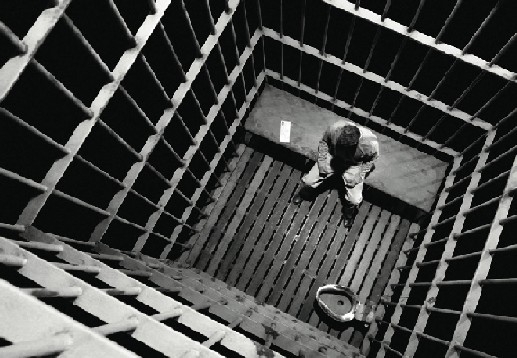The failure of development is closely tied to the ossification of big institutional structures.
The World Bank was born as a vehicle for reconstructing Europe after World War II, a task it carried out with amazing success. But when it morphed into a massive institution to address global poverty, it didn’t do so well. Schumacher launched a revolution in design with his admirable book, Small is Beautiful, but the appropriate technology institutions that emerged from it became ossified, failed to address market forces and died.

The Politics of Innovation
I define institutions as radical ideas cast in concrete.
The radical notion that education should be available for the masses gave birth to our existing educational institutions which operate more as assembly line sausage stuffers than creative learning environments.
The revolutionary idea that a thief should be rehabilitated instead of cutting off his hand or killing him evolved into the notion that this could be best accomplished by placing him in a monastic cell conducive to spiritual reflection.


It only took creative planners a few years to apply the concepts of the economies of scale by piling large numbers of monastic cells on top of each other to give birth to our present correctional monstrosities, which offer intensive training in advanced burglary techniques and a graduation gift of the ex-con brand which makes it extremely difficult to ever land a decent job.
Is there an inevitable political process by which turns radical innovation into conventional wisdom and which gives birth to ossified institutions whose perverse effects can only be addressed by the next disruptive innovation?
I hope not.
I have devoted my life to fomenting a revolution in design and a revolution in big business centered on serving the other 90% of the world’s customers.
But I am increasingly concerned that we might only be successful in creating the next generation of ossified destructive institutions.
I can’t get it out of my head that French revolution gave us Napoleon Bonaparte.
And the steam engine created the wage slavery of the industrial revolution at the same time it helped millions move out of poverty.

The Russian revolution gave us Joseph Stalin whose new institutions of control and repression implemented the famine in the Ukraine that successfully exterminated 20 million members of the proletariat who dared to express ideas of Ukrainian nationalism
In the Communist Manifesto, Karl Marx said
“The history of all hitherto existing societies is the history of class struggle” ——-freeman and slave, lord and serf, guild-master and journeyman, in a word oppressor and oppressed, stood in constant opposition to each other —(in)—-a fight that ended, either in a revolutionary re-constitution of society at large, or in the common ruin of the contending classes”——-.
“The immediate aim of the Communist is the————formation of the proletariat into a class, overthrow of the bourgeois supremacy, conquest of political power by the proletariat”
Inspired by Marx’s dream, bloody revolutions in the name of the proletariat seized power in Russia, Vietnam, China and Cambodia.

But the institutions installed by these revolutions replaced the existing ruling class with new elite drawn from the proletariat, whose excesses in personal enrichment and mass extermination of perceived enemies quickly put their predecessors to shame. Mao moved into the Imperial Palace in the Forbidden City, organized the efficient recruitment of more concubines than the emperors who preceded him, and engineered a famine that starved 40 million peasants to death.
If we are successful in fomenting revolutions in design and big business to serve the poor people of the world, how do we know that this won’t give birth to institutions that are just as destructive as the institutions created by the revolutions in China, Russia, and Cambodia?
I have no answers to this question.
But I believe that people who foment revolutions should also assume responsibility for probable ill effects.
With this in mind, here are some initial questions and ideas about the destructive institutions that could emerge if the revolutions in design and big business I dream of become successful.
Institutionalizing Design for the Poor
I have talked to teams of students designing new de-mining tools without ever having visited a mine field, students designing tools to make charcoal without understanding how poor people improve their incomes by selling the charcoal briquettes they make, and teams of students so convinced that they will create the next revolutionary product and make a fortune doing it that they forget to talk to the customers they are designing for. If these patterns of design arrogance and lack of respect and curiosity about customers and markets become institutionalized in the hundreds of new courses now springing to teach design for the poor, their impacts will be just as trivial as design for the rich. Building an institutional structure which makes ongoing learning about customers and markets an inherent part of the design process is the sure cure for this predictable malady of the design revolution.

Inserting Bottom Billion Prosperity in the DNA of Big Business Serving Poor Customers
The revolution to create new international businesses that profitably serves poor customers may get so distracted by money and profits that they revert to the mass marketing of effectively branded useless products and services. I think the only way to prevent this is to make improving the livelihoods of the 2.6 billion $2 a day people in the world a permanent part of the mission of each new company. The problem is that I don’t really know how to accomplish this.
Institutionalizing Peace
When IDE helped farmers in India who were virtual serfs to waterlords gain access to their own water by installing treadle pumps, they didn’t attack their previous lords and masters. They were happy to augment their incomes by hiring on to the farms of waterlords as laborers. With a level playing field in access to water, they were able to negotiate much more attractive wages. I have no doubt that creating a level playing field that gives poor people open access to income-generating tools, information, and markets is a much more effective tool to improve the lives of the proletariat than fomenting eternal violent class struggle with the bourgeoisie.
Institutionalizing Democratization of Power
Many people have warned me that helping poor farmers improve their livelihoods will anger the power structure and do no good for my continued health. But I’m still alive and healthy, and more convinced than ever that a million farmers with treadle pumps are hard to stop. I agree with those who say that a root cause of poverty is powerlessness. But political power, especially in rural villages, is inextricably tied to economic power. I have talked to hundreds of small farm families whose growing prosperity coincided with growing respect and influence in their communities.
Ossified Big Institutions- Origins and Remedies
Institutionalizing Disruptive Innovation
This is probably the most difficult thing to pull off I can think of. As IDE began to grow I did my best to instill a culture of ongoing innovation and contrarian thinking into the institutional structure that was rapidly emerging. I’m still not sure how to institutionalize disruptive innovation, but I know that it requires a decentralized leadership structure, and an ongoing process of empowerment and out of the box thinking for all of the players in the organization – the very same processes that poor people need to master to successfully move out of poverty.

Paul, there are several monumental points in this blog post.
It could/should be broken down into several follow up posts, to be sure
people get each key point. This is “must read” information. Thanks for sharing!
SS
I think monumental is the word to use. Lot’s of room for great discussions.
Well written.
To me the most pressing question you address is the issue of. I find this problem myself–I’m 1,500 miles away from the action. I can do research, but can’t do face to face interviews with local farmers, local customers, or local leaders (and certainly can’t do walk-abouts to see what the market challenges and opportunities are).
I think this problem is pronounced in the case of this movement because it requires a $750 to 1,250 investment just to get started with market research and realistically more (when you’re talking about college kids this is a larger % of their overall budget). And once on ground–where to start? Its hard to also find mentors in that sort of environment… Its possible that the use of low cost video conferencing systems like Skype to connect to Kenya, India, and other countries **may** help create a more transparent–to allow prototypes to be better informed before testing them in the field.
I think more investigation of lowering the barriers to entry or the current gaps in the industry might be an interesting discussion on your blog.
As for the risk of cooption of the movements goals or work–I think the risk is extremely, extremely low. And if the players are that committed to their path–they probably would have done it anyway (ie character and motivation overwhelms the cultural, economic, and environmental changes). And its probably the case that your work has actually undermined the very forces to give rise to those sorts of concerns and risks.
Cooption would also passionately galvanize the movement (your movement along with the larger forces of social change) to come together with resources, solutions, and alliances. I think you would have a lot of allies that you may not be considering.
I would think that it would be primarily on a location by location basis. In other words, would only involve a small percentage of farmers–rather than all of them.
I think 5 things also fight against that risk:
1) slow speed of farming season
2) decentralization (centralized power seems to be the problem in the example you described, because its winner take all)
3) the low margins involved
4) I think you create a lot of win-win solutions, which coopts challenges and creates a shared communal interest in positive social change.
5) the relationships and trust you’ve cultivated over the years
Again–to return to the beginning–I think the main issue is of creating an environment of lower risk, lower barriers, and more potential collaboration for potential and passionate entrepreneurs in the space.
Nathan
Thank you for your thoughtful comments. You bring up some really good points such as thinking through the ways that we can bring more understanding without the need to travel. Your specifically talking about students who are on a tight budget. Which of course is a reality. That said in the development process it is absolutely essential that we train designers around the world to develop their products and businesses that have a deep understanding of the culture and markets they serve. What good is a graveyard of good ideas and designs if the have no hope of reaching scale. The problem of profitability is the problem of tenacity. As Paul says to relentless in the pursuit of affordability. Why develop the product to a bottom line cost that customers can’t afford and won’t buy.
As far as what how the Design Revolution could become an institution I really don’t know but its worth thinking through and discussing.
I just watched a video TEDxUM (University of Michigan), which speaks to this issue. I think the visual metaphor he uses is quite helpful for thinking about these issue (as well as the issues of intercultural dialogue and the problem of silos in organization) is a fish in a bowl.
You can see his explanation at 12:15 in the video and only lasts about 60 seconds or so:
http://cfe.umich.edu/sociale/blog/?p=213
I think the analogy of gifts at Christmas works too. About 1/2 of what we get is well meaning…but often these well meaning gifts just sit as wasted objects in the closet. The solution of “wish lists” or options which open up the process help provide more useful solutions.
I think, though the problem of entrepreneurs and designers “getting out of the building” to test their assumptions and to get feedback is particularly hard if they haven’t done so in the past, but also a moderate care over from our individualistic culture and tech.
I think you are totally right about ossified organizations. They really put the brakes on development.
I am not part of any ossified organization and it is sure hard to get them to acknowledge or look at any of my contributions. (Some of which need simple testing before poor people will try them). Alternative energy is not windmills or low head hydro anymore. These have been accepted 20 years ago. But you would never know if you ask the alternative energy gurus. Stuff like what I do is REAL alternative energy. The pulser pump, The clam shaped solar cookers, the tracking solar accumulator project. The pulser pump is proven but nobody has even tried the others. And now I have started a bio-fueled water pump. I have done the proof of concept, first prototype and it works. It will be YEARS! before real engineers or scientists try it but already a lady in Texas is ready to go and will put her results on youtube.
Harvesting the pressurized gas from lactic acid bacteria rotting away food or garden waste will provide enough power to recirculate water or compost tea to make plants grow better.
Paul- Thanks for this provocative article. Most of us in development keep running into these bureaucratic, ossified institutions since a lot of them hold the purse strings to the kind of money that can really make a difference in our work.
My hope is that as our consciousness and perspectives shift to more global dimensions, we will have a new cadre of socially minded, innovative enterprises that are capable of looking within their own operational and management structures and weeding out inefficiencies and barriers to innovation. For this to happen we need exemplary leaders who never loose sight of their larger mission nor the multitude of people working to manifest it. We need companies who are ready to adopt an ethical code of conduct that provides a moral compass to guide their actions, both within their organization and in the world at large. We need organizations that are able to create a balance between meeting the ego-needs of the individual without sacrificing the larger goal of making a true difference in the world.
Pingback: Wenn die Revolution direkt in die Versteinerung führt « Aus dem Hollerbusch
Pingback: humanitarian.info » Blog Archive » A United Nations for the Real World
Pingback: De-Ossification Strategies | humanitarian.info
fantastic post, very informative. I’m wondering why the other experts of this sector do not understand this.
You must continue your writing. I am confident, you’ve a great readers’ base already!